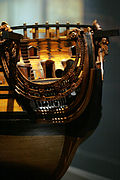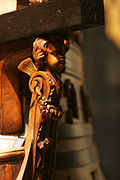- Stern of the Soleil Royal, design by Jean Bérain
- Stern of the Soleil Royal, design by Jean Bérain
- The action at La Hogue on 23 May 1692
- The Battle of La Hogue by Benjamin West, 1778
This article needs additional citations for verification .(January 2022) |
 Soleil Royal on fire at the action at La Hogue | |
| History | |
|---|---|
| | |
| Laid down | December 1668 |
| Launched | 13 December 1669 |
| Completed | August 1670 |
| Commissioned | 1671 (?) |
| Out of service | The night of June 2nd and 3rd 1692 |
| Fate | Destroyed by fireships |
| General characteristics | |
| Displacement | 2,500 tonneaux |
| Tons burthen | 2,400 port tonneaux |
| Length | 61 m (200 ft) |
| Beam | 15.64 m (51.3 ft) |
| Draught | 7.64 m (25.1 ft) |
| Propulsion | sails |
| Complement | 836 |
| Armament | |
Soleil Royal (Royal Sun) was a 104-gun ship of the line of the French Navy. She was the flagship of Admiral Anne Hilarion de Tourville.
Contents
- Career
- Battle of Beachy Head
- Battle of Barfleur
- Battle at Cherbourg and the end of the Soleil Royal
- Legacy
- See also
- Citations
- References
She was built in Brest, France between 1668 and 1670 by shipwright Laurent Hubac, was launched in 1669, and stayed unused in the Brest harbour for years. She was recommissioned with 112 guns and 1200 men when the Nine Years' War broke out in 1688 as the flagship of the Ponant Fleet.
She was said to be a good sailing ship and her decorations were amongst the most beautiful and elaborate of all baroque flagships. The emblem of the "sun" had been chosen by Louis XIV as his personal symbol.








